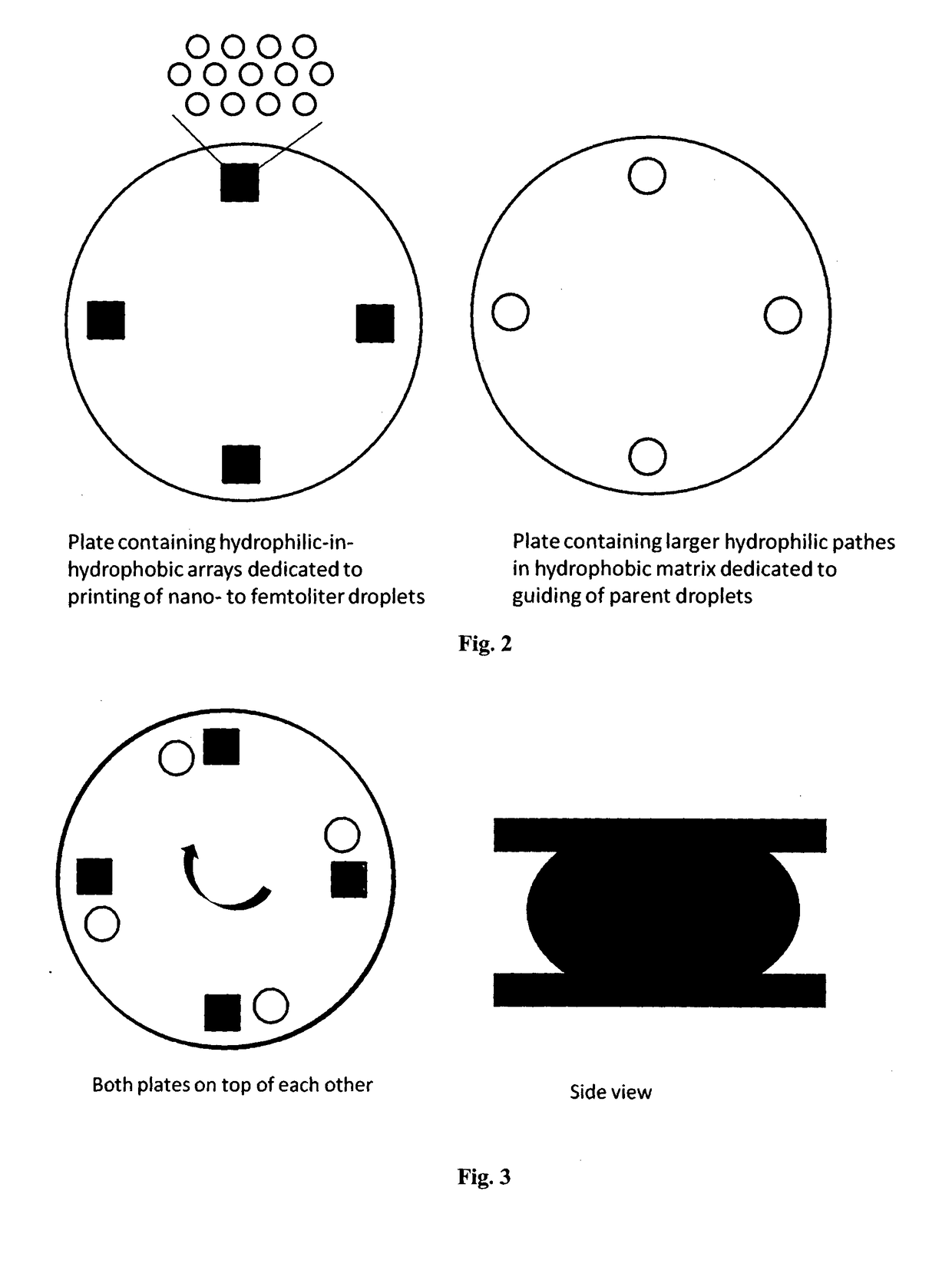Patterning device
a technology of a patterning device and a spherical plate, which is applied in the direction of laboratory apparatus, nanotechnology, chemical/physical/physicochemical processes, etc., can solve the problems of limited methods in the minimum amount of volume, high cost of inkjet systems, and inability to achieve high-speed printing, so as to facilitate the movement towards and inside the hydrophilic elements.
- Summary
- Abstract
- Description
- Claims
- Application Information
AI Technical Summary
Benefits of technology
Problems solved by technology
Method used
Image
Examples
example 1
Crystal Array Formation
[0124]An aqueous NaCl solution (5 M) or was transported 20 times over an array of hydrophilic-in-hydrohobic micropatches, resulting in an array of single NaCl crystals (FIG. 4).
example 2
on of an Array for Printing of Oligonucleotides and Aptamer Selection
[0125]Digital microfluidic chips are fabricated as follows: glass wafers are cleaned in acetone and isopropyl alcohol for 5 minutes. A thin layer of chromium (100 nm) is then deposited by magnetron sputtering (Balzers BAE 370, Pfaffikon, Switzerland). The chromium layer is patterned by standard photolithographic processes using 51818 positive photoresist, chrome-on-glass photomasks, and wet etching using Cyantec CR-7 chromium etchant. Next, chips are cleaned in 02-plasma (150 mtorr, 100 W) and primed with silane A174 before being coated with a layer of Parylene-C(3 μm) which was deposited using chemical vapor deposition (AL 200, Plasma Parylene Coating Services, Rosenheim, Germany). A thin layer of TEFLON-AF® (˜200 nm thickness, 3% w / w in Fluorinert FC-40) is subsequently spincoated (1200 rpm) on top of the Parylene-C layer, and baked for 5 minutes at 110° C., and 5 minutes at 200° C. Crenellated actuation electrod...
example 3
ic-in-Hydrophobic Microwells
[0174]Hydrophilic-in-hydrophobic microwells were fabricated as follows. Glass slides were coated with TEFLON-AF® to a thickness of 3.25 μm. Next, a thin Parylene-C membrane (500 nm) was deposited on top of the TEFLON-AF® surface by using chemical vapor deposition. Subsequently, an aluminum hard mask (50 nm thickness) was deposited on top of the polymeric stack by thermal evaporation. This aluminum hard mask was patterned by standard photolithography and wet etching to obtain an array of circular features having 4 μm diameter. The exposed areas of the protective Parylene-C mask and TEFLON-AF® were then etched with reactive ion etching using 02-plasma before the protective Parylene-C mask was removed by mechanical peeling.
[0175]The glass slide containing these hydrophilic-in-hydrophobic micropatterns was subsequently used as a top plate of a double-plate digital microfluidic chip based on electrowetting-on-dielectric (FIG. 8).
[0176]For demonstrating the pri...
PUM
 Login to View More
Login to View More Abstract
Description
Claims
Application Information
 Login to View More
Login to View More - R&D
- Intellectual Property
- Life Sciences
- Materials
- Tech Scout
- Unparalleled Data Quality
- Higher Quality Content
- 60% Fewer Hallucinations
Browse by: Latest US Patents, China's latest patents, Technical Efficacy Thesaurus, Application Domain, Technology Topic, Popular Technical Reports.
© 2025 PatSnap. All rights reserved.Legal|Privacy policy|Modern Slavery Act Transparency Statement|Sitemap|About US| Contact US: help@patsnap.com



